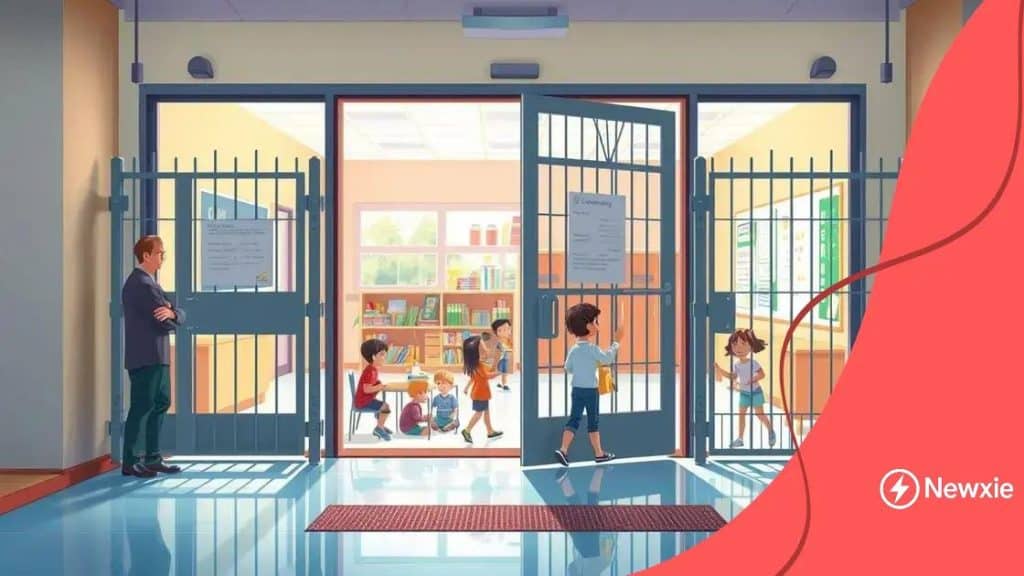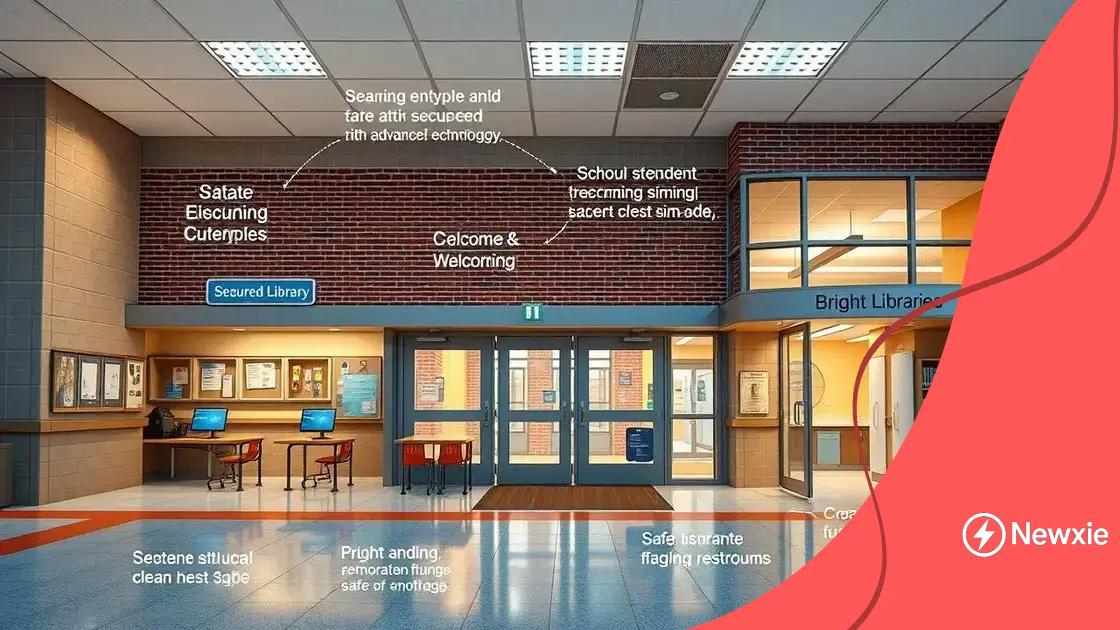Government funding initiatives to improve school safety

Anúncios
Government funding initiatives to improve school safety enhance security through technology upgrades, mental health resources, and strong community involvement, resulting in safer learning environments.
Government funding initiatives to improve school safety are crucial for creating environments where children can learn free from fear. Have you ever thought about what makes a school truly safe? Let’s explore these vital programs.
Understanding government funding for school safety
Anúncios
Understanding government funding for school safety is essential for creating secure learning environments. These funds come from various sources, aiming to support schools in implementing necessary safety measures.
This funding can cover a wide range of initiatives, from upgrading facilities to enabling new security technologies. For instance, schools might use funds to improve their entry points, install surveillance systems, or even provide training for staff on emergency preparedness.
Types of Government Funding
Government funding for school safety can be categorized into federal, state, and local grants. Each type plays a crucial role in shaping safety measures across schools.
- Federal Grants: Programs like the Secure Schools Grant Program provide substantial resources for safety initiatives.
- State Funding: Many states allocate specific budgets aimed at enhancing school safety.
- Local Initiatives: School districts can create their own safety funds, often using local tax revenue.
It’s important for schools to stay informed about available funding opportunities. This ensures they can apply for the necessary resources to protect students and staff effectively. The process can be competitive, requiring clear proposals and justifications for the funding needed.
Anúncios
Impact on School Safety
Ultimately, understanding these funding sources allows schools to implement greater safety measures. By investing in infrastructure and training, schools can create a more secure environment for education. This, in turn, helps instill confidence in parents and students alike.
Every step taken with the assistance of government funding contributes toward a comprehensive safety strategy, reflecting a community’s commitment to education and well-being. The goal is not just to react to potential threats, but to proactively build a culture of safety that enables students to thrive.
Key initiatives improving safety in schools
Key initiatives improving safety in schools have become vital for ensuring a secure learning environment. Schools are increasingly adopting various programs to enhance safety measures for students and staff.
One significant initiative is the implementation of comprehensive safety plans. These plans often include protocols for emergencies, training staff and students in safety drills, and establishing communication systems for alerts.
Technological Advancements
Another area of focus is on technological advancements. Schools are investing in modern technologies to bolster their security.
- Access Control Systems: Controlled entry points help manage who can enter the school premises.
- Surveillance Cameras: Monitoring systems allow for improved oversight and quick response to incidents.
- Emergency Notification Systems: These systems enable immediate communication during emergencies, ensuring everyone is informed.
In addition to technology, schools are prioritizing mental health resources. By providing counseling services and support systems, schools can address potential threats before they escalate. This focus not only improves student well-being but also fosters a positive learning environment.
Community Involvement
Community involvement is central to enhancing school safety. Engaging parents and local organizations can lead to collaborative efforts in safety initiatives.
- Workshops and Training: Community workshops can educate families and children about safety protocols.
- Volunteer Programs: Local volunteers can assist in monitoring activities during school events.
- Partnerships with Law Enforcement: Collaborating with local police can create safer environments through regular safety assessments.
These key initiatives highlight the multifaceted approach required to improve safety in schools. By combining modern technology, mental health support, and community engagement, schools are taking important steps to ensure a secure and conducive learning atmosphere for all.
How funding impacts school infrastructure

How funding impacts school infrastructure is a critical aspect of ensuring safe and effective learning environments. Adequate funding allows schools to maintain and improve their facilities, which directly influences student safety and learning outcomes.
For example, funds can be used for upgrading older buildings to meet modern safety standards. This often includes reinforcing structures, updating electrical systems, and improving accessibility for all students. When schools invest in infrastructure, it helps create a more inviting and productive atmosphere for learning.
Modernization of Facilities
Another significant impact of funding is the modernization of educational spaces. Many schools are now rethinking traditional classrooms to better suit today’s educational needs.
- Flexible Learning Spaces: Open areas allow teachers to adapt lessons and encourage collaboration among students.
- Improved Technology Access: Funding can lead to enhanced technology setups, like smart boards and high-speed internet.
- Enhanced Safety Features: Modernizing facilities includes installing advanced safety systems, like fire alarms and secure entrances.
These changes not only provide better educational tools but also ensure student safety and well-being. As a result, students feel more comfortable and engaged in their learning environment.
Community Support and Engagement
In addition to structural improvements, funding enables schools to engage with their communities. Schools can create programs that invite community input, fostering a sense of ownership among residents.
- Community Workshops: Schools can host workshops to gather ideas on safety and improvement needs.
- Partnerships with Local Businesses: Engaging local businesses can provide additional resources and support for infrastructure projects.
- Public Awareness Campaigns: Funded projects can raise awareness about the importance of safe, modern schools.
When funding supports infrastructure, it creates a ripple effect that enhances the educational experience. The impact is felt not only by students but also by teachers, staff, and the community.
Community involvement in funding initiatives
Community involvement in funding initiatives is crucial for enhancing school safety. Engaging the community helps to build strong support networks that benefit both students and schools. When communities come together, they can create a safer and more nurturing environment for children.
One effective way to encourage community involvement is through partnerships. Schools can collaborate with local businesses, organizations, and volunteers to raise funds and awareness for safety programs. These partnerships can lead to valuable resources and support that schools might not have on their own.
Examples of Community Engagement
There are many ways communities can become actively involved in school funding initiatives.
- Fundraising Events: Hosting events like bake sales, fun runs, or community fairs can raise money for safety initiatives while bringing people together.
- Volunteer Programs: Local residents can volunteer to assist with school activities, mentoring programs, or safety training, which in turn helps strengthen community ties.
- Awareness Campaigns: Community members can participate in campaigns that highlight the importance of school safety and encourage contributions to funding efforts.
By creating a culture of involvement, schools can tap into the wealth of support available within their communities. This collaboration not only helps to secure funding but also fosters a sense of ownership and pride among residents.
Building Stronger Relationships
Community involvement also leads to stronger relationships between schools and families. When parents and local organizations are engaged in school initiatives, they feel more connected to the educational process. This connection results in parents becoming more invested in their children’s education and safety.
Additionally, when schools actively seek input from the community, they can better understand the specific needs and concerns that parents and residents have. This ensures that the funding initiatives are relevant and effective. Schools can use feedback to adapt their programs and address issues that matter most to their communities.
Success stories of funded safety programs
Success stories of funded safety programs illustrate the positive impact that effective financing can have on school security. Many programs have transformed the safety landscape in schools, showing results that benefit students, staff, and the community.
One famous example is the implementation of a security enhancement program in various districts. Schools used grants to install security cameras and upgrade entry systems. As a result, incidents of unauthorized access significantly decreased, leading to safer environments.
Enhanced Mental Health Programs
Funding has also supported mental health initiatives, which play a crucial role in prevention. Programs providing mental health resources have been implemented in schools funded through various grants.
- Counseling Services: Schools introduced more counselors to offer support to students facing challenges.
- Workshops: Regular workshops focusing on coping strategies have helped students manage stress and anxiety.
- Peer Support Groups: These groups encourage a sense of community and provide students with safe spaces to discuss their feelings.
These initiatives have led to improved student well-being and reduced incidents of violence, showcasing how funding can lead to a more comprehensive approach to safety.
Community Partnership Success
Collaboration with local communities has proven effective in many funded safety programs. Schools fostering partnerships with local law enforcement have seen significant improvements.
- Regular Safety Drills: Joint efforts have facilitated regular safety drills that prepare both students and staff for emergencies.
- Resource Sharing: Local police provide resources and expertise, enhancing overall safety strategies.
- Community Events: Events organized together improve communication and trust between schools and the community.
These success stories demonstrate that when schools and communities work together, they can create safer environments for education. The funding allocated to these initiatives has a lasting impact, ensuring that safety remains a priority.
FAQ – Frequently Asked Questions about Government Funding Initiatives for School Safety
How do funding initiatives improve school safety?
Funding initiatives enhance school safety by providing resources for technology, training, and infrastructure improvements.
What are some examples of funded safety programs?
Examples include installing security cameras, mental health resources, and community engagement workshops.
Why is community involvement important in school funding initiatives?
Community involvement brings valuable support, resources, and awareness, helping schools to secure necessary funds and enhance safety.
How can schools measure the success of safety programs?
Schools can assess success through reduced incidents, improved student well-being, and feedback from students, staff, and parents.
SEE MORE CONTENT




